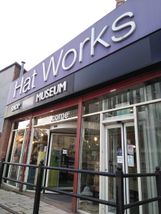More Stockport History
Once, everyone wore a hat and the making of them was a proud speciality of the area. So much so, that people from Denton would not wear a hat made in Stockport and vice versa. If you were seen on your day off not wearing a hat when you worked in a hatting factory, your wages (meagre to start with) would be docked. It began as a cottage industry, labour intensive enough, the fur flayed from rabbit skins and then 'bowed' with a catgutted instrument to 'make the fur fly' so that the long process of felting could begin. Once industrialised it was, as with all such hellholes, many times worse - the workers, barehanded, dipping into boiling water with dilute sulphuric acid in it, repeatedly. The foreman tasted this vile brew and if it was like lemonade, it was right. There was a dry part (the processing of the fur into conical felt starter hats) and the wet part (shrinking, rolling, melting shellac in to harden the creation and then shaping by pulling the hat in the making over carved wooden blocks, cutting and trimming to finish). It took a seven year apprenticeship to learn the trade, which had the added value to the employer of keeping their workers' wages low. Despite their blisters, breathing problems, even madness from mercury poisoning (another one time aspect of curing the felt), there was humour. The wooden box the fur was dried in was called 'the confessional'. The museum holds presently silent machines, now bizarre looking curios whose purpose, without our tour guide, it would have been impossible to guess at. It was fascinating stuff and the cellars of the Stockport workers' dwellings featured in Engels' 'The Condition of the English Working Class' as amongst the worst he had encountered. That said, hatting and the associated work of printing, hat box making and design, haberdashery shops and trimming necessities were once the mainstay of the local economy. The outcome, a smoothly turned out hat for all public occasions and appearances in places of elegance, such as going to the the still extant Art Deco Plaza Cafe, seemed, after seeing all that, little short of miraculous. The museum gallery holds some fine examples of their craft.
Share this page



























